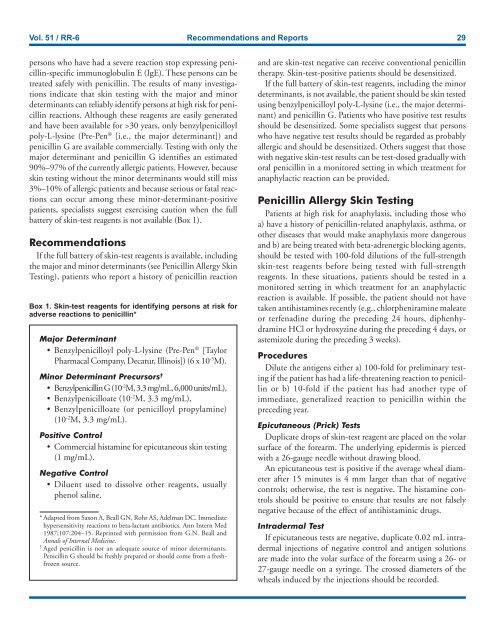Create successful ePaper yourself
Turn your PDF publications into a flip-book with our unique Google optimized e-Paper software.
Vol. 51 / RR-6 Recommendations and Reports 29<br />
persons who have had a severe reaction stop expressing penicillin-specific<br />
immunoglobulin E (IgE). These persons can be<br />
treated safely with penicillin. The results of many investigations<br />
indicate that skin testing with the major and minor<br />
determinants can reliably identify persons at high risk for penicillin<br />
reactions. Although these reagents are easily generated<br />
and have been available for >30 years, o<strong>nl</strong>y benzylpenicilloyl<br />
poly-L-lysine (Pre-Pen ® [i.e., the major determinant]) and<br />
penicillin G are available commercially. Testing with o<strong>nl</strong>y the<br />
major determinant and penicillin G identifies an estimated<br />
90%–97% of the currently allergic patients. However, because<br />
skin testing without the minor determinants would still miss<br />
3%–10% of allergic patients and because serious or fatal reactions<br />
can occur among these minor-determinant-positive<br />
patients, specialists suggest exercising caution when the full<br />
battery of skin-test reagents is not available (Box 1).<br />
Recommendations<br />
If the full battery of skin-test reagents is available, including<br />
the major and minor determinants (see Penicillin Allergy Skin<br />
Testing), patients who report a history of penicillin reaction<br />
Box 1. Skin-test reagents for identifying persons at risk for<br />
adverse reactions to penicillin*<br />
Major Determinant<br />
Benzylpenicilloyl poly-L-lysine (Pre-Pen ® [Taylor<br />
Pharmacal Company, Decatur, Illinois]) (6 x 10 -5 M).<br />
Minor Determinant Precursors †<br />
Benzylpenicillin G (10 -2 M, 3.3 mg/mL, 6,000 units/mL),<br />
Benzylpenicilloate (10 -2 M, 3.3 mg/mL),<br />
Benzylpenicilloate (or penicilloyl propylamine)<br />
(10 -2 M, 3.3 mg/mL).<br />
Positive Control<br />
Commercial histamine for epicutaneous skin testing<br />
(1 mg/mL).<br />
Negative Control<br />
Diluent used to dissolve other reagents, usually<br />
phenol saline.<br />
* Adapted from Saxon A, Beall GN, Rohr AS, Adelman DC. Immediate<br />
hypersensitivity reactions to beta-lactam antibiotics. Ann Intern Med<br />
1987;107:204–15. Reprinted with permission from G.N. Beall and<br />
Annals of Internal Medicine.<br />
† Aged penicillin is not an adequate source of minor determinants.<br />
Penicillin G should be freshly prepared or should come from a freshfrozen<br />
source.<br />
and are skin-test negative can receive conventional penicillin<br />
therapy. Skin-test-positive patients should be desensitized.<br />
If the full battery of skin-test reagents, including the minor<br />
determinants, is not available, the patient should be skin tested<br />
using benzylpenicilloyl poly-L-lysine (i.e., the major determinant)<br />
and penicillin G. Patients who have positive test results<br />
should be desensitized. Some specialists suggest that persons<br />
who have negative test results should be regarded as probably<br />
allergic and should be desensitized. Others suggest that those<br />
with negative skin-test results can be test-dosed gradually with<br />
oral penicillin in a monitored setting in which treatment for<br />
anaphylactic reaction can be provided.<br />
Penicillin Allergy Skin Testing<br />
Patients at high risk for anaphylaxis, including those who<br />
a) have a history of penicillin-related anaphylaxis, asthma, or<br />
other diseases that would make anaphylaxis more dangerous<br />
and b) are being treated with beta-adrenergic blocking agents,<br />
should be tested with 100-fold dilutions of the full-strength<br />
skin-test reagents before being tested with full-strength<br />
reagents. In these situations, patients should be tested in a<br />
monitored setting in which treatment for an anaphylactic<br />
reaction is available. If possible, the patient should not have<br />
taken antihistamines recently (e.g., chlorpheniramine maleate<br />
or terfenadine during the preceding 24 hours, diphenhydramine<br />
HCl or hydroxyzine during the preceding 4 days, or<br />
astemizole during the preceding 3 weeks).<br />
Procedures<br />
Dilute the antigens either a) 100-fold for preliminary testing<br />
if the patient has had a life-threatening reaction to penicillin<br />
or b) 10-fold if the patient has had another type of<br />
immediate, generalized reaction to penicillin within the<br />
preceding year.<br />
Epicutaneous (Prick) Tests<br />
Duplicate drops of skin-test reagent are placed on the volar<br />
surface of the forearm. The underlying epidermis is pierced<br />
with a 26-gauge needle without drawing blood.<br />
An epicutaneous test is positive if the average wheal diameter<br />
after 15 minutes is 4 mm larger than that of negative<br />
controls; otherwise, the test is negative. The histamine controls<br />
should be positive to ensure that results are not falsely<br />
negative because of the effect of antihistaminic drugs.<br />
Intradermal Test<br />
If epicutaneous tests are negative, duplicate 0.02 mL intradermal<br />
injections of negative control and antigen solutions<br />
are made into the volar surface of the forearm using a 26- or<br />
27-gauge needle on a syringe. The crossed diameters of the<br />
wheals induced by the injections should be recorded.


